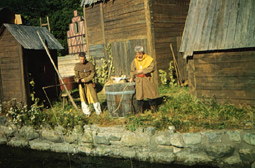Meet the Middle Ages
BackFishing villages

There were people on the coast who lived solely or partially from fishing. Some peasants only fished at certain times of the year, or when there was a lot of fish. Then the fishing villages were crowded with town-dwellers and country peasants.
A fishing village could be a few simple houses and some sheds for tools and boats. Some people only stayed for a couple of days, others fished for months. This depended on the supply of fish and on what other tasks had to be done on the farm or in town. Foundations of medieval fishermen’s simple huts can still be found in many places along the coasts.
At some places, where the fishery was especially rich, large numbers of people gathered. A whole town could spring up temporarily during the fishing season. This was the case in Skanör in Skåne , and in Sikavarp and Kyrkhamn on Öland during the rich fishery in the 13th and 14th centuries. Not only fishermen or merchants came. There were also craftsmen, who made and sold their ware. Minstrels and pipers performed and danced. Taverns opened. Priests conducted services in the chapel. Friars came there to talk and to help people.
Fishing was vital, not only to those who fished, but also to the merchants who traded with fish. Along the Norwegian Atlantic coast, great amounts of cod were fished. It was dried and then sold in the town of Bergen. From there, it was shipped to Europe by the Hanseatic merchants. This trade was so important to Bergen, that the dried fish can be seen on its City Arms.